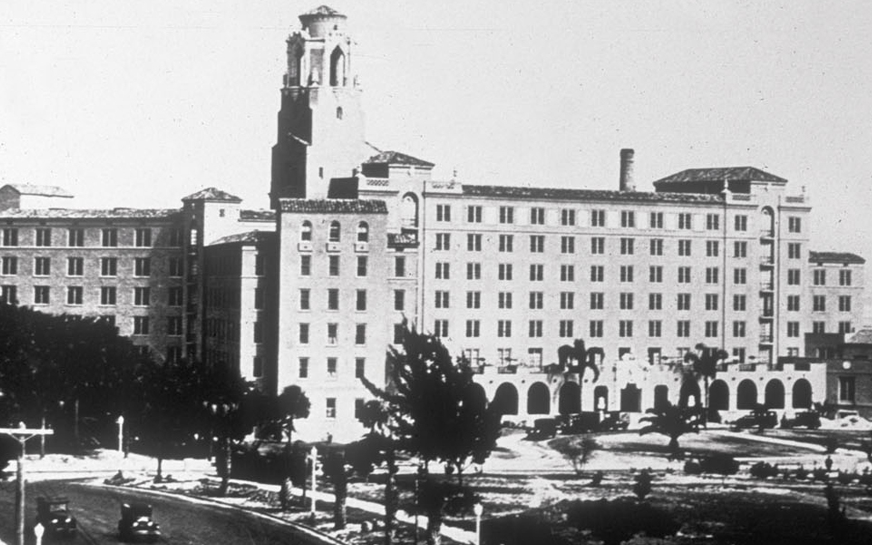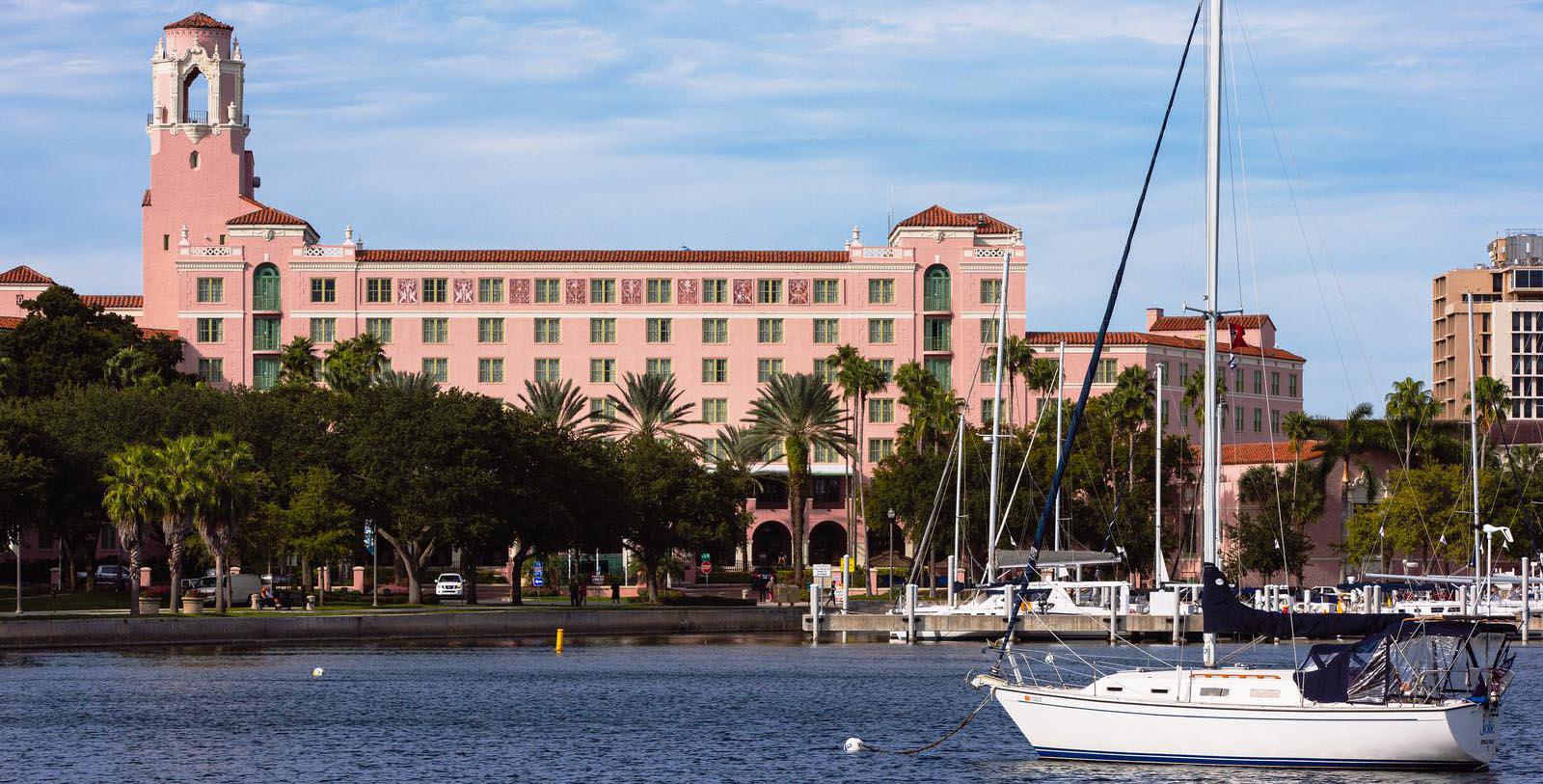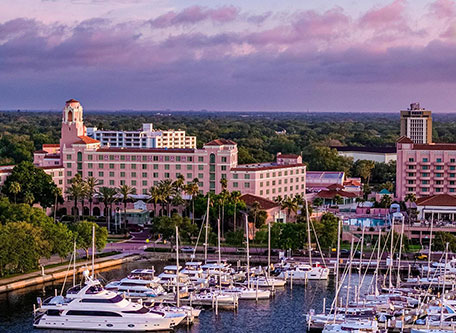Receive for Free - Discover & Explore eNewsletter monthly with advance notice of special offers, packages, and insider savings from 10% - 30% off Best Available Rates at selected hotels.
historic hotel st. petersburg, fl
Discover The Vinoy Resort & Golf Club, Autograph Collection, a luxury Mediterranean Revival style-hotel designed by architect Henry L. Taylor.
The Vinoy Resort & Golf Club, Autograph Collection, a member of Historic Hotels of America since 1991, dates back to 1925.
VIEW TIMELINE
Experience The Vinoy Resort & Golf Club, Autograph Collection
Discover the luxurious amenities and vaunted history of The Vinoy Hotel, this fantastic and historic hotel in St. Petersburg, FL. See its award-winning spa, championship golf course, and the fantastic Marchand’s Bar & Grill.
WATCH NOWA member of Historic Hotels of America since 1991, The Vinoy Resort & Golf Club, Autograph Collection is among the most fantastic holiday destinations in Florida. Yet, this famous historic hotel in St. Petersburg, FL first came into existence in the early 1920s following a bet made during a friendly game of golf. A wealthy Pennsylvania businessman named Aymer Vinoy Laughner had relocated to St. Petersburg some years prior, and had quickly built a strong reputation throughout the community. Among the many friends he entertained was the famed golfer Walter Hagen. During one of the parties at Laughner’s beautiful, Craftsmen-style home, the business magnate got into a cheery dispute with Hagen over the power of his drive. Laughner specifically attested that Hagen’s swing—while powerful—had no chance of damaging the crystal within his personal pocket watch. The haggling reached its crescendo when Hagen wagered a bet of $170,000 that he could, indeed, smash its glass casing. Placing the watch firmly on the ground, Hagen proceeded to forcefully launch a number of golf balls several dozen yards away on a distant neighbor’s lawn. But much to the golfer’s surprise, the watch had somehow survived the contest unscathed. Flabbergasted, Hagen surrendered all the money to a grinning Laughner. Afterward, a few party guests mused that Laughner ought to use that money to build a spectacular holiday destination in downtown St. Petersburg. Yet, the enterprising Laughner realized they had inadvertently made a great a point. Florida was in the midst of a prosperous land boom, driven by the vast creation of resort and hotels across the state. St. Petersburg itself was one of the main areas where this commercial development had taken place.
Wasting no time at all, Laughner spent a sum of his winnings on a sizable plot of land in St. Petersburg. He then hired architect Henry L. Taylor to oversee its design and George A. Miller to supply the labor. Construction commenced in February of 1925, with hundreds of people working on the building practically all the time. Amazingly, Taylor and Miller had completed the project in a then-record setting ten months. What they had accomplished was nothing short of spectacular, either. Its grand architecture had the new resort resemble the great historical palaces and villas of Europe’s Mediterranean coastline. Every single one of the building’s 375 guestrooms and suites offered the most cutting-edge amenities and services. The lobby soared some 25 feet in height, and contained a gorgeous vaulted ceiling with hand-stenciled cypress beams and many ornate chandeliers. A brilliant Pompeiian-themed ballroom resided within the space, as did a gorgeous two-story dining room that was filled with Georgian-inspired design aesthetics. When the resort debuted as the “Vinoy Park Hotel” on New Years’ Eve of 1925, it amazing all the guests who stepped inside. Word traveled quickly about the new building’s splendor, attracting all sorts of esteemed individuals from across the United States. At first, members of America’s most powerful families—like the Pillsburys and the Fleischmanns—frequented the resort. But soon enough, Hollywood celebrities, influential authors, and celebrated athletes all spent time at the Vinoy Park Hotel at one point or another. Perhaps its greatest guests included U.S. Presidents, as both Calvin Coolidge and Herbert Hoover stayed at the resort. In fact, patrons even reported spying President Coolidge eating in privacy in the hotel’s employee cafeteria!
The Vinoy Park Hotel remained incredibly popular among Northerners, even as the Great Depression started to grip at the nation. Many of those guests had continued to travel south as a means of escaping the harsh winter weather of their own states. But while the resort managed to survive through the era’s difficult economic climate, war ultimately put a stop to business. Just several months after the United States entered into World War II, the Vinoy Park Hotel shutdown in order to support the national war effort. In July of 1942, its ownership leased the entire facility to the U.S. Army Air Force for the use of military housing. It was then subsequently transformed into a barracks and training center for members of the U.S. Maritime Service. By the time the facility closed in late 1944, more than 100,000 servicemen had pass through the Vinoy Park Hotel at one point or another. Fortunately, the resort was able to rebound swiftly, reopening that December following a series of major renovations. Charles H. Alberding then acquired the business a year later, purchasing the resort outright for a sum of $700,000. He continued to manage the resort’s ascent back to St. Petersburg’s most luxurious retreat, offering to guests unrivaled hospitality and service. Renowned luminaries even began to return frequently, making the Vinoy Park Hotel once again a great place to catch a glimpse of a celebrity. Throughout the 1950s and the 1960s, for instance, Yankee legend Joe DiMaggio was often caught sneaking into the resort alongside his starlet wife, the actress Marilyn Monroe.
Yet, the Vinoy Park Hotel struggled to remain relevant among the nation’s travelers, as its services and amenities became increasingly dated. By the early 1970s, the resort had fallen into such ill repute that it had no choice but to generate business as a low-rent boarding house that offered a mere $7 dollars for a single night. Nevertheless, the great Vinoy Hotel closed its doors for good in 1975, following one last ditch effort to resurrect the business a year earlier. Nearly all of resort’s spectacular china and furniture was sold at auction, and the building fell into disrepair. Heartbroken, local residents throughout St. Petersburg rushed to save the ailing historic structure from potential demolition, holding a special referendum on the subject in 1984. They even successfully petitioned the U.S. Department of the Interior to list the Vinoy Park Hotel on the prestigious National Register of Historic Places. Salvation finally arrived in 1989, when the St. Petersburg-based Federal Construction Company received $33.6 million to completely reinvigorate the historic Vinoy Park Hotel. Construction began a few months later, which lasted for more than two years. The architects and engineers worked diligently, restoring the building’s historic character with great skill. The project wound up yielding several interesting surprises, too. In one memorable occasion, some workers had even managed to locate a hidden vault that contained more than 1,400 silver pieces of silverware—they had all been wrapped in newspaper dated from 1934!
The Federal Construction Company had also managed to greatly expand the Vinoy Park Hotel during the construction, as well. Its team subsequently built another guest tower, three separate spas, and a fully-equipped fitness center. Other facilities included an 18-hole championship-caliber golf course, two new outdoor swimming pools, and several state-of-the-art tennis courts. There was even a 74-slip marina onsite! (Right before the construction ended, the resort’s temporary owners made it a member of Historic Hotels of America.) In 1992, the Vinoy Park Hotel reopened as the “Stouffer Hotel.” Yet, its newfound identity was short-lived, as Renaissance Hotels—then a subsidiary of Ramada Inns—acquired the entire facility and renamed it as the “The Vinoy Renaissance St. Petersburg Resort & Golf Club.” Renaissance Hotels was later acquired by Marriott International in 1997, making the resort part of the Marriott family of holiday destinations. Marriott has since ensured that the grand eloquence of The Vinoy is never extinguished again. It has since experience another series of renovations, which saw the makeover of its interior spaces. Such areas that received attention were the Lobby Promenade Lounge, the Presidential Suites and the restaurant, Marchand’s Bar & Grill. In a Marriott rebranding, the name has now changed to The Vinoy Resort & Golf Club, Autograph Collection. No where else is better for a spectacular vacation than this incredibly historic Grande Dame.
-
About the Location +
Located at the southern end of the Pinellas Peninsula along Tampa Bay, the history of St. Petersburg, Florida, is immensely interesting. The earliest people to frequent the region were Native Americans, who occupied the space for generations. But in the early 16th century, a pair of the Spanish explorers journeyed through the area in search of fame and treasure. The first of the two adventurers—Pánfilo de Narváez—arrived in 1528 with an army of some 300 men. Heading deep into the interior, his party reemerged from its trek with just four survivors! Narváez himself had died, too, as the raft he used during his return trip was swept away into the Gulf of Mexico. Undeterred, Hernando de Soto arrived with his own troop a decade later. From Tampa Bay, de Soto ventured all across what is now the Deep South, reaching as far as the banks of the Mississippi River in present-day Louisiana. Like his predecessor, Hernando de Soto had died while leading his expedition. Nevertheless, Florida became part of the Spanish Empire for the next three centuries, save for a brief period in the mid-1700s when it was a British colony. While Pinellas Peninsula remained relatively isolated, settlers stared to congregate toward the northern end of Tampa Bay shortly after the United States acquired Florida from Spain in 1821. The main force behind the development was the U.S. Army, which had dispatched four companies of soldiers to erect a fort.
Known as “Fort Brooke,” the citadel and its garrison effectively served as the only settled community in the entire region. Fort Brooke served as an important post as it defended against the attacks by the Seminoles, who, since the 1810s, had continuously challenged the settlement of the area. When the fighting ceased toward the middle of the century, other settlers started to move to Tampa Bay in large numbers. Pinellas Peninsula was an afterthought for many though, and it remained an undeveloped wetland through the American Civil War. But when Florida began its transformation into a luxurious vacation hotspot in the years after the conflict, some Americans finally recognized the commercial real estate value of the region. One such person was John C. Williams, a transplant from Detroit, Michigan, who had travelled south in search of prospective economic opportunities. In 1875, he purchased a large plot of land in the Pinellas Peninsula from Captain Peter Demens and subsequently convinced him to help found a brilliant new city. Although it grew slowly, the new City of St. Petersburg received a formal charter from the Florida state legislature in February of 1892. Local legend has it that Williams and Demens chose the name of “St. Petersburg” with a coin flip. Demens won the toss, deciding to name the new community after St. Petersburg, Russia. Both Williams and Demens quickly set about developing their new community into an exclusive resort town. The two specifically constructed a magnificent hotel in the center of St. Petersburg that Williams christened in honor of his birthplace.
The town’s population nonetheless remained fairly small, only numbering a few people at the dawn of the 20th century. At the time, the economy of St. Petersburg operated on commercial fishing and other small enterprises. Its maritime commerce improved significantly over the next several years, as city officials began dredging the local harbor into a deep-water port. However, several important developments transpired during 1910 that ultimately turned the city into a popular vacation retreat. Al Lang convinced the St. Louis Browns to relocate its spring training facilities to St. Petersburg, creating the tradition in which many professional baseball clubs held their preseason activities in the area. Furthermore, commercial airplane flights began running exclusively to St. Petersburg, beginning with Tony Jannus and his Benoist XIV flying boat. Those two developments—combined with the town’s naturally beautiful beaches—had quickly made it one of Florida’s most well-known destinations. By the 1920s, thousands of tourists from throughout the Northeast had descended upon St. Petersburg for an enjoyably relaxing holiday. As with most coastal Floridian towns, a massive land boom subsequently erupted throughout St. Petersburg. Dozens of outstanding hotels and resorts—including the Vinoy Park Hotel—debuted, as such. Today, St. Petersburg has since continued to be one of Florida’s most outstanding locations.
-
About the Architecture +
When architect Henry L. Taylor first designed The Vinoy Resort & Golf Club, Autograph Collection, he used a central block consisting of seven stories with four canted wings. Designed with Mediterranean Revival-style architecture, Taylor constructed each section with a reinforced concrete frame that he eventually coated with clay tile and stucco. Three of the four extensions only extended upward for five stories and primarily housed nothing but luxurious guestrooms. Only the southeastern wing was spatially diverse, as it was home to several public spaces that included the spectacular dining room. To the north of the central building featured a smaller facility that operated as the grand ballroom. Then, to the west, Taylor erected a stunning observation tower that managed to eclipse the entire facility by several stories. The tower itself was a magnificent display, covered with fine stuccoed baroque detailing. Brilliant clay tile covered the roof of the tower, as well as the other five structures that comprised the main body of the resort. Inside, the ornate decorations continued to appear frequently. Scrafitto murals lined the sides of every window on the top story, as well as the entire length of the ballroom’s interior façade. The lobby and its accompanying mezzanine possessed a wealth of decorative floor tiling and beautiful vaulted ceilings. A combination of leather and wrought iron chandeliers appeared regularly, while wall sconces and stenciled cypress beams proliferated throughout every public space. But Taylor somewhat broke with the overall theme of the building, using Georgian architecture to create the interior of the massive ballroom room. Pompeiian-inspired artwork and décor also defined the dining room, as did a stunning colonnade and a monumental leaded-glass window. Furthermore, according to the U.S. Department of the Interior:
- “Individual rooms were also sumptuously furnished. The furniture of the guest rooms is hairwood, which is deep gray in color, and striped with a one-inch band of walnut. Draperies are of striped mohair in shades of rose and green…Blankets are a gray plaid, cut and bound single to match the top blankets…These were brought out in light gray with Grecian key border, the crest being woven in both borders. The bedspreads are tan with rose or green stripes to match the decorations.”
Mediterranean Revival-style architecture itself is a gorgeous—but rather peculiar—structural aesthetic. Popular among American architects at the height of the Roaring Twenties, its main characteristic was its intrinsic eclecticism. While most Revivalist styles typically mimicked one or two earlier architectural forms, Mediterranean Revival-style took its inspiration from several, including Italian Renaissance, Spanish Colonial, and French Beaux-Arts. The amalgamation of so many unique design principles into one singular form was born out of a desire to create exotic buildings that closely resembled the different kinds of historic palaces scattered throughout the Mediterranean basin. As the modern hospitality industry exploded in Florida and California in the 1920s and early 1930s, American architects—as well as the hoteliers who served as their clients—hoped such an appearance would epitomize the tropical atmosphere of their respective states. But they also wished that the new style would significantly impress the throngs of tourists that had started to south and west as a means of escaping the harsh winters of the Northeast. As such, Mediterranean Revival-style architecture was predominantly used to create luxurious hotels and resorts, although some affluent Americans began using the form to construct their own personal homes. Architects August Gieger and Addison Mizner were the two most prominent professionals to popularize the style in Florida, while the likes of Bertram Goodhue and Sumner Spaulding used it frequently in California. Mediterranean Revival-style typically relied on a regular, rectangular floorplan that featured grandiose, symmetrical façades. Stucco exterior walls and red-tile roofs were perhaps the greatest structural elements. Yet, American architects also incorporated wrought iron balconies into the overall design, as well as numerous keystones and arched windows with grilles.
-
Famous Historic Guests +
Jimmy Stewart, actor known for his roles in such films like Mr. Smith Goes to Washington, The Man Who Shot Liberty Vance, and It’s a Wonderful Life.
Marilyn Monroe, actress known for her roles in Bus Stop and Some Like It Hot.
Paul Newman, actor known for his roles in such films like Cool Hand Luke, The Sting, and Butch Cassidy and the Sundance Kid.
Eartha Kitt, singer and actress known for such songs as “C’est si bon” and “Santa Baby.”
B.B. King, musician hailed throughout the world as “The King of the Blues.”
Ernest Hemingway, author known for writing such books like A Farwell to Arms and The Old Man and the Sea.
Babe Ruth, legendary outfielder for the New York Yankees who is regarded today as the best baseball player ever.
Joe DiMaggio, outfielder for the New York Yankees best remembered as the “Yankee Clipper.”
Richard Byrd, Admiral in the U.S. Navy who earned the Medal of Honor for his supposed exploration of the North Pole.
Calvin Coolidge, 30th President of the United States (1923 – 1929)
Herbert Hoover, 31st President of the United States (1929 – 1933)
-
Film, TV and Media Connections +
The Break (1995)































